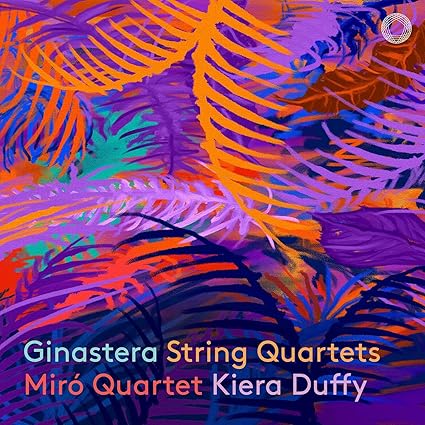

String Quartet No. 1, Op. 20 (1948) String Quartet No. 2, Op. 26 (1958, rev. 1968) String Quartet No. 3, Op. 40 (1973, rev. 1978)
Argentinian composer Alberto Evaristo Ginastera (1916-1983) was to South American classical music the counterpart to what Aaron Copland brought to American classical music. After all, during a stay in the United States in the 1940s he studied with Aaron Copland. There's a strong native folk element to his music, especially obvious within his early works. A prime example of this, and without a doubt one of my favorite works from the Americas, is his ballet Estancia. Nothing rivals this music when it comes to driving, even euphoric Latin American rhythmic energy.
The booklet notes denote that "Ginastera himself in his writings divided his music into three periods: Objective Nationalism, Subjective Nationalism, and Neo-Expressionism. Objective Nationalism integrates Argentine folk elements in a straightforward fashion - In Subjective Nationalism, direct quotes and obvious symbolism has been absorbed organically into a distinctive dissonant and modernist style that nonetheless is infused with Argentine elements - The late Neo-Expressionist style, again rather like the style of Beethoven in his Late Quartets, inhabits a mystical world of imagination and expression unique to Ginastera, deeply probing and evocative, and at times even elusive."
This new recording serves as a comprehensive survey of Ginastera's output. I myself much prefer the Quartet No. 1, Op. 20. Somewhat like Aaron Copland's Rodeo which celebrates the cowboy life, it pays homage to the hard-working backbone of Argentina, the horsemen and gauchos who work the land. Its raw, visceral rhythmic pulse and energy pulls you in. As well, its mysteriously beautiful Calmo e poetico slow movement, evokes images of nightmarish fear and torment along with the peaceful quietude of sleeping under a canopy of stars.
The more abstract Quartet No. 2, Op. 26 better exposes Ginastera's contrapuntal skills. And once again the Adagio angoscioso (distressing) slow movement "suggesting the quietness of the pampas" is quite affecting in its imagery. Its Presto magico that follows calls upon all four musicians to generate some unusually odd sounds, something the members of the Miró Quartet execute convincingly well. The energy with which the final Furioso movement ends is, well, furious.
Set to texts (mostly spoken rather than sung) from poems written by three famous Spanish twentieth century poets: Juan Ramón Jiménez, Federico García Lorca, and Rafael Alberti, the Quartet No. 3, Op. 40 finds Ginastera exploring experimental techniques. In his own words, the quartet contains "strange sounds and contrasting atmospheres ... it develops in a hallucinating climate" {Booklet Notes}. And once again I find that its slow Amoroso movement displays some amazing harmonic writing.
The Miró Quartet's list of recordings covers a large swath of styles and eras from Beethoven to George Crumb. This new release makes for a perfect addition to an already esoteric discography. Something avid music CD collectors should appreciate.
Jean-Yves Duperron - July 2025 Quartet No. 2 - Opening Movement